CycleGAN-master
说明: CycleGAN本质上是两个镜像对称的GAN,构成了一个环形网络。
两个GAN共享两个生成器,并各自带一个判别器,即共有两个判别器和两个生成器。一个单向GAN两个loss,两个即共四个loss。
(CycleGAN is essentially two GAN's with symmetrical mirror images, forming a ring network. Two GAN's share two generators, and each with a discriminator, that is, there are two discriminators and two generators.One one-way GAN, two loss, two is a total of four loss.)
(CycleGAN is essentially two GAN's with symmetrical mirror images, forming a ring network. Two GAN's share two generators, and each with a discriminator, that is, there are two discriminators and two generators.One one-way GAN, two loss, two is a total of four loss.)
文件列表:
LICENSE (3565, 2019-08-13)
data (0, 2019-08-13)
data\aligned_data_loader.lua (1400, 2019-08-13)
data\base_data_loader.lua (1299, 2019-08-13)
data\data.lua (2725, 2019-08-13)
data\data_util.lua (764, 2019-08-13)
data\dataset.lua (14094, 2019-08-13)
data\donkey_folder.lua (6171, 2019-08-13)
data\unaligned_data_loader.lua (1502, 2019-08-13)
datasets (0, 2019-08-13)
datasets\bibtex (0, 2019-08-13)
datasets\bibtex\cityscapes.tex (393, 2019-08-13)
datasets\bibtex\facades.tex (253, 2019-08-13)
datasets\download_dataset.sh (1261, 2019-08-13)
datasets\prepare_cityscapes_dataset.py (4127, 2019-08-13)
examples (0, 2019-08-13)
examples\test_vangogh_style_on_ae_photos.sh (845, 2019-08-13)
examples\train_maps.sh (781, 2019-08-13)
imgs (0, 2019-08-13)
imgs\failure_putin.jpg (100725, 2019-08-13)
imgs\horse2zebra.gif (7686299, 2019-08-13)
imgs\objects.jpg (697802, 2019-08-13)
imgs\painting2photo.jpg (1473658, 2019-08-13)
imgs\paper_thumbnail.jpg (8914, 2019-08-13)
imgs\photo2painting.jpg (480890, 2019-08-13)
imgs\photo_enhancement.jpg (1149235, 2019-08-13)
imgs\season.jpg (416910, 2019-08-13)
imgs\teaser.jpg (567079, 2019-08-13)
models (0, 2019-08-13)
models\architectures.lua (18199, 2019-08-13)
models\base_model.lua (1619, 2019-08-13)
models\bigan_model.lua (9023, 2019-08-13)
models\content_gan_model.lua (7364, 2019-08-13)
models\cycle_gan_model.lua (12910, 2019-08-13)
models\one_direction_test_model.lua (2167, 2019-08-13)
models\pix2pix_model.lua (7639, 2019-08-13)
options.lua (7679, 2019-08-13)
... ...
data (0, 2019-08-13)
data\aligned_data_loader.lua (1400, 2019-08-13)
data\base_data_loader.lua (1299, 2019-08-13)
data\data.lua (2725, 2019-08-13)
data\data_util.lua (764, 2019-08-13)
data\dataset.lua (14094, 2019-08-13)
data\donkey_folder.lua (6171, 2019-08-13)
data\unaligned_data_loader.lua (1502, 2019-08-13)
datasets (0, 2019-08-13)
datasets\bibtex (0, 2019-08-13)
datasets\bibtex\cityscapes.tex (393, 2019-08-13)
datasets\bibtex\facades.tex (253, 2019-08-13)
datasets\download_dataset.sh (1261, 2019-08-13)
datasets\prepare_cityscapes_dataset.py (4127, 2019-08-13)
examples (0, 2019-08-13)
examples\test_vangogh_style_on_ae_photos.sh (845, 2019-08-13)
examples\train_maps.sh (781, 2019-08-13)
imgs (0, 2019-08-13)
imgs\failure_putin.jpg (100725, 2019-08-13)
imgs\horse2zebra.gif (7686299, 2019-08-13)
imgs\objects.jpg (697802, 2019-08-13)
imgs\painting2photo.jpg (1473658, 2019-08-13)
imgs\paper_thumbnail.jpg (8914, 2019-08-13)
imgs\photo2painting.jpg (480890, 2019-08-13)
imgs\photo_enhancement.jpg (1149235, 2019-08-13)
imgs\season.jpg (416910, 2019-08-13)
imgs\teaser.jpg (567079, 2019-08-13)
models (0, 2019-08-13)
models\architectures.lua (18199, 2019-08-13)
models\base_model.lua (1619, 2019-08-13)
models\bigan_model.lua (9023, 2019-08-13)
models\content_gan_model.lua (7364, 2019-08-13)
models\cycle_gan_model.lua (12910, 2019-08-13)
models\one_direction_test_model.lua (2167, 2019-08-13)
models\pix2pix_model.lua (7639, 2019-08-13)
options.lua (7679, 2019-08-13)
... ...

# CycleGAN ### [PyTorch](https://github.com/junyanz/pytorch-CycleGAN-and-pix2pix) | [project page](https://junyanz.github.io/CycleGAN/) | [paper](https://arxiv.org/pdf/1703.10593.pdf) Torch implementation for learning an image-to-image translation (i.e. [pix2pix](https://github.com/phillipi/pix2pix)) **without** input-output pairs, for example:
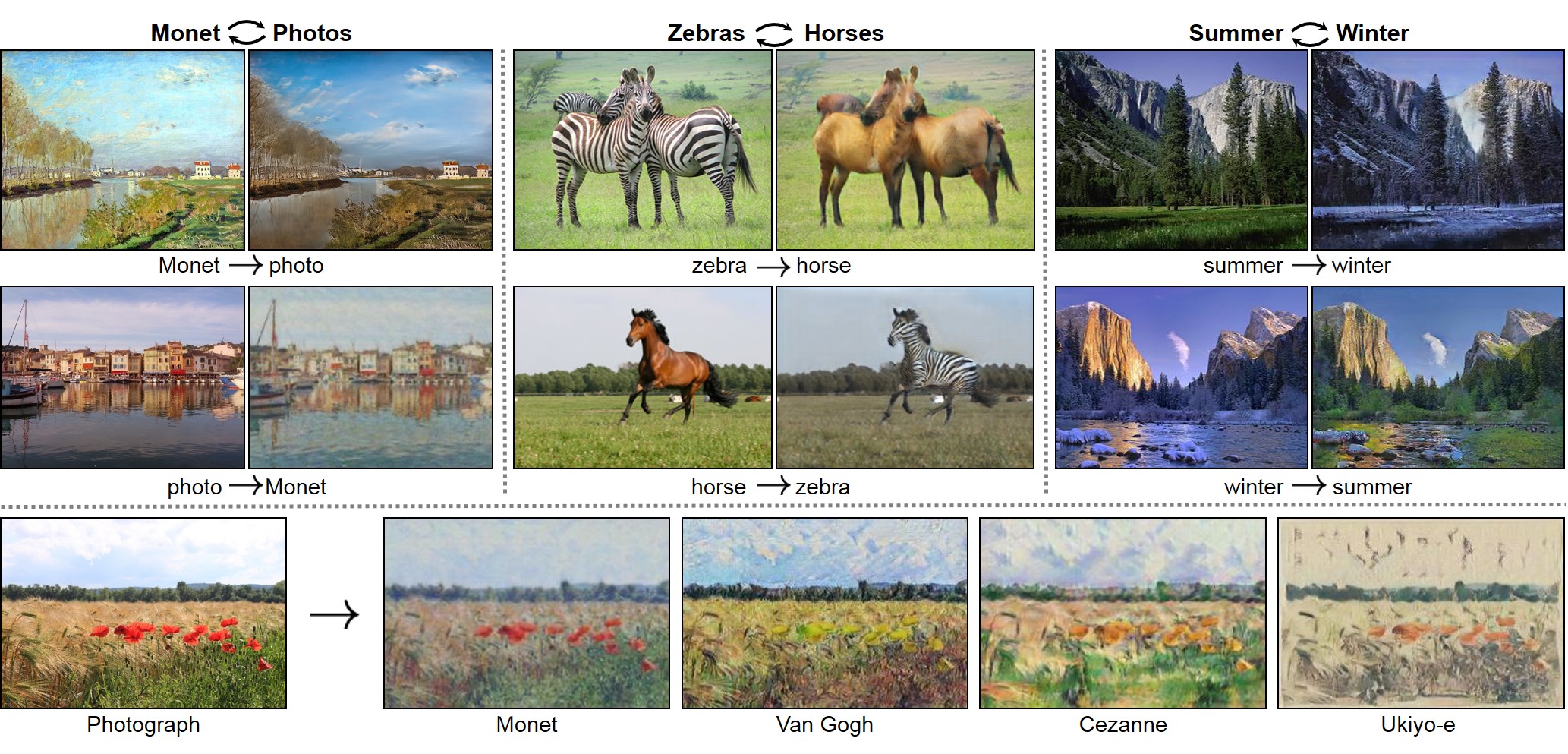 [Unpaired Image-to-Image Translation using Cycle-Consistent Adversarial Networks](https://junyanz.github.io/CycleGAN/)
[Jun-Yan Zhu](https://people.eecs.berkeley.edu/~junyanz/)\*, [Taesung Park](https://taesung.me/)\*, [Phillip Isola](http://web.mit.edu/phillipi/), [Alexei A. Efros](https://people.eecs.berkeley.edu/~efros/)
Berkeley AI Research Lab, UC Berkeley
In ICCV 2017. (* equal contributions)
This package includes CycleGAN, [pix2pix](https://github.com/phillipi/pix2pix), as well as other methods like [BiGAN](https://arxiv.org/abs/1605.09782)/[ALI](https://ishmaelbelghazi.github.io/ALI/) and Apple's paper [S+U learning](https://arxiv.org/pdf/1612.07828.pdf).
The code was written by [Jun-Yan Zhu](https://github.com/junyanz) and [Taesung Park](https://github.com/taesung).
**Update**: Please check out [PyTorch](https://github.com/junyanz/pytorch-CycleGAN-and-pix2pix) implementation for CycleGAN and pix2pix.
The PyTorch version is under active development and can produce results comparable or better than this Torch version.
## Other implementations:
[Unpaired Image-to-Image Translation using Cycle-Consistent Adversarial Networks](https://junyanz.github.io/CycleGAN/)
[Jun-Yan Zhu](https://people.eecs.berkeley.edu/~junyanz/)\*, [Taesung Park](https://taesung.me/)\*, [Phillip Isola](http://web.mit.edu/phillipi/), [Alexei A. Efros](https://people.eecs.berkeley.edu/~efros/)
Berkeley AI Research Lab, UC Berkeley
In ICCV 2017. (* equal contributions)
This package includes CycleGAN, [pix2pix](https://github.com/phillipi/pix2pix), as well as other methods like [BiGAN](https://arxiv.org/abs/1605.09782)/[ALI](https://ishmaelbelghazi.github.io/ALI/) and Apple's paper [S+U learning](https://arxiv.org/pdf/1612.07828.pdf).
The code was written by [Jun-Yan Zhu](https://github.com/junyanz) and [Taesung Park](https://github.com/taesung).
**Update**: Please check out [PyTorch](https://github.com/junyanz/pytorch-CycleGAN-and-pix2pix) implementation for CycleGAN and pix2pix.
The PyTorch version is under active development and can produce results comparable or better than this Torch version.
## Other implementations:
[Tensorflow] (by Harry Yang), [Tensorflow] (by Archit Rathore), [Tensorflow] (by Van Huy), [Tensorflow] (by Xiaowei Hu), [Tensorflow-simple] (by Zhenliang He), [TensorLayer] (by luoxier), [Chainer] (by Yanghua Jin), [Minimal PyTorch] (by yunjey), [Mxnet] (by Ldpe2G), [lasagne/Keras] (by tjwei), [Keras] (by Simon Karlsson)
## Applications ### Monet Paintings to Photos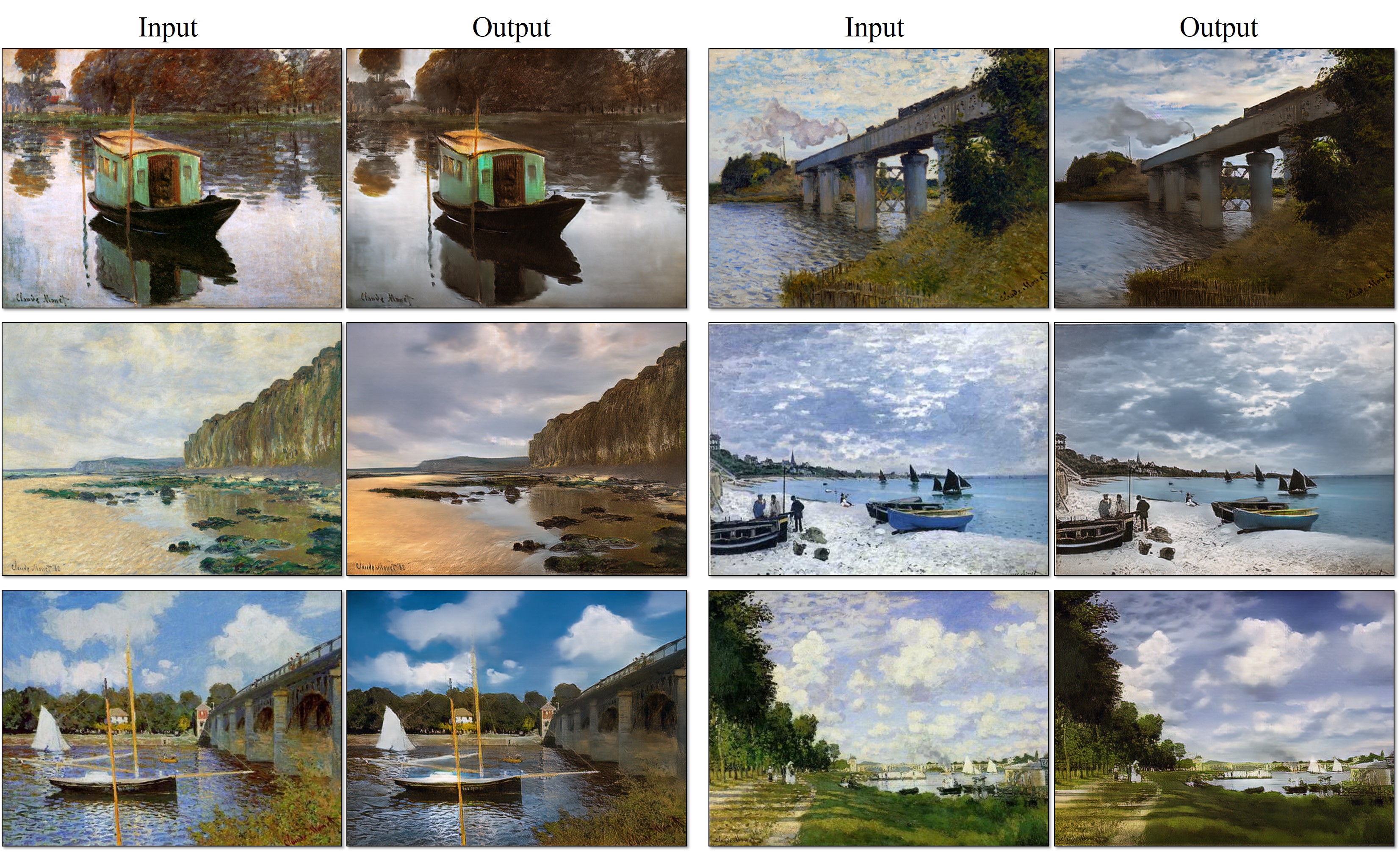 ### Collection Style Transfer
### Collection Style Transfer
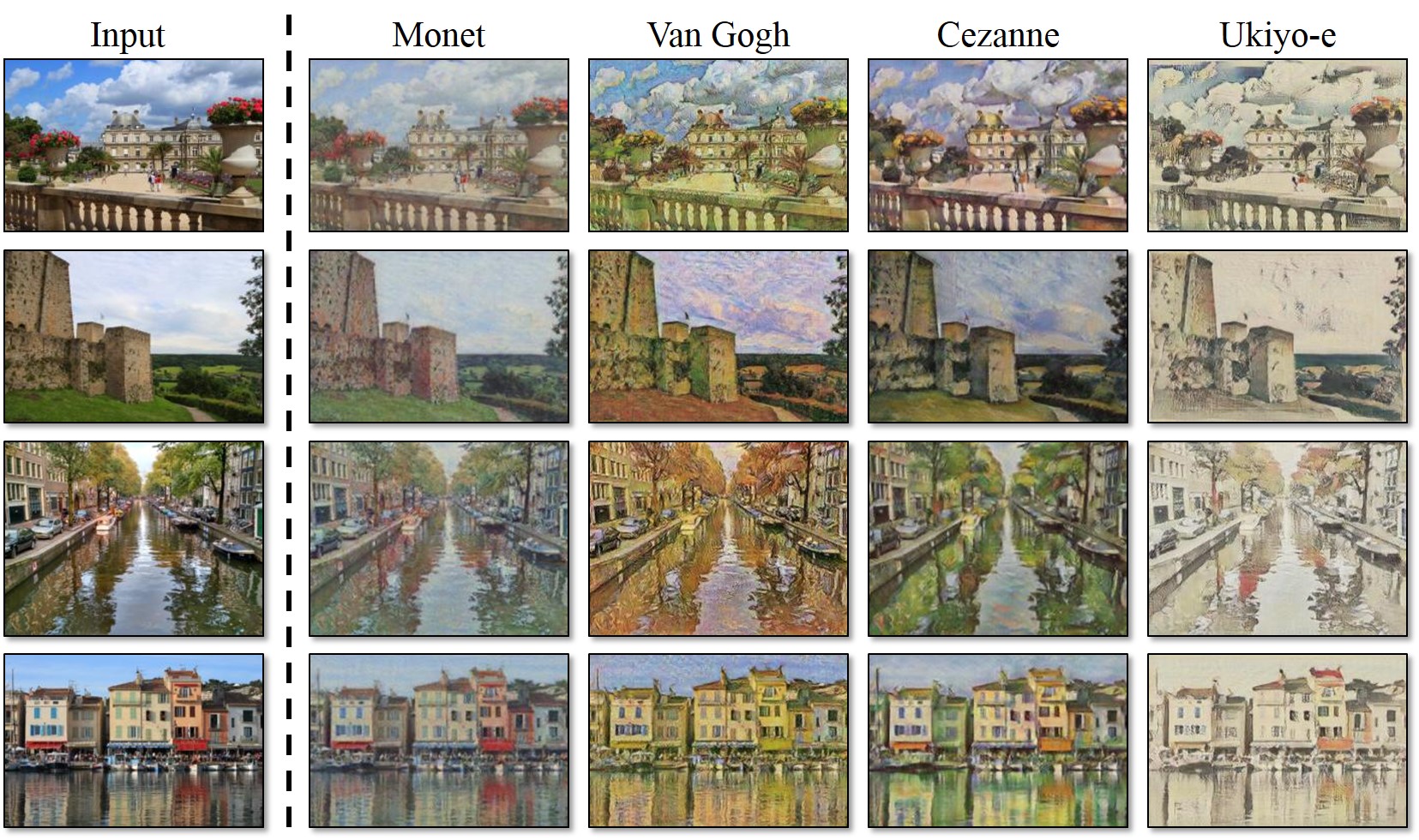 ### Object Transfiguration
### Object Transfiguration
 ### Season Transfer
### Season Transfer
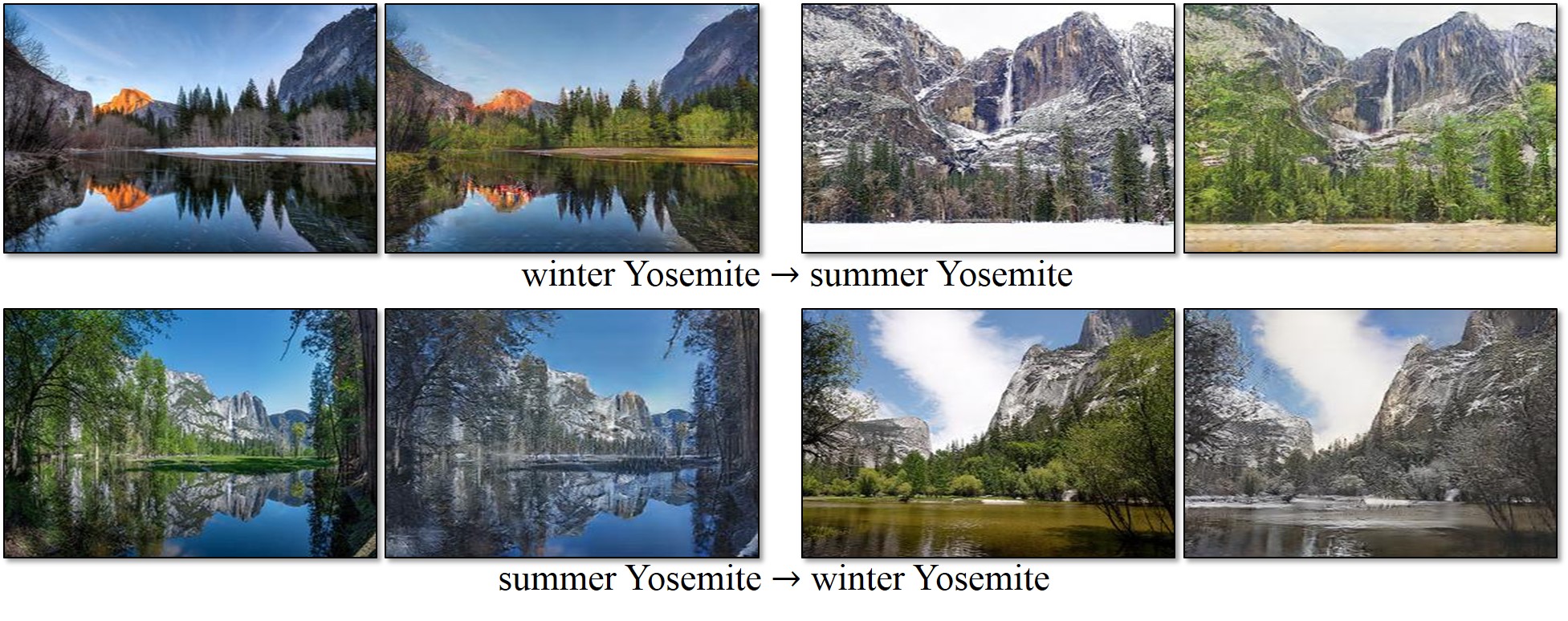 ### Photo Enhancement: Narrow depth of field
### Photo Enhancement: Narrow depth of field
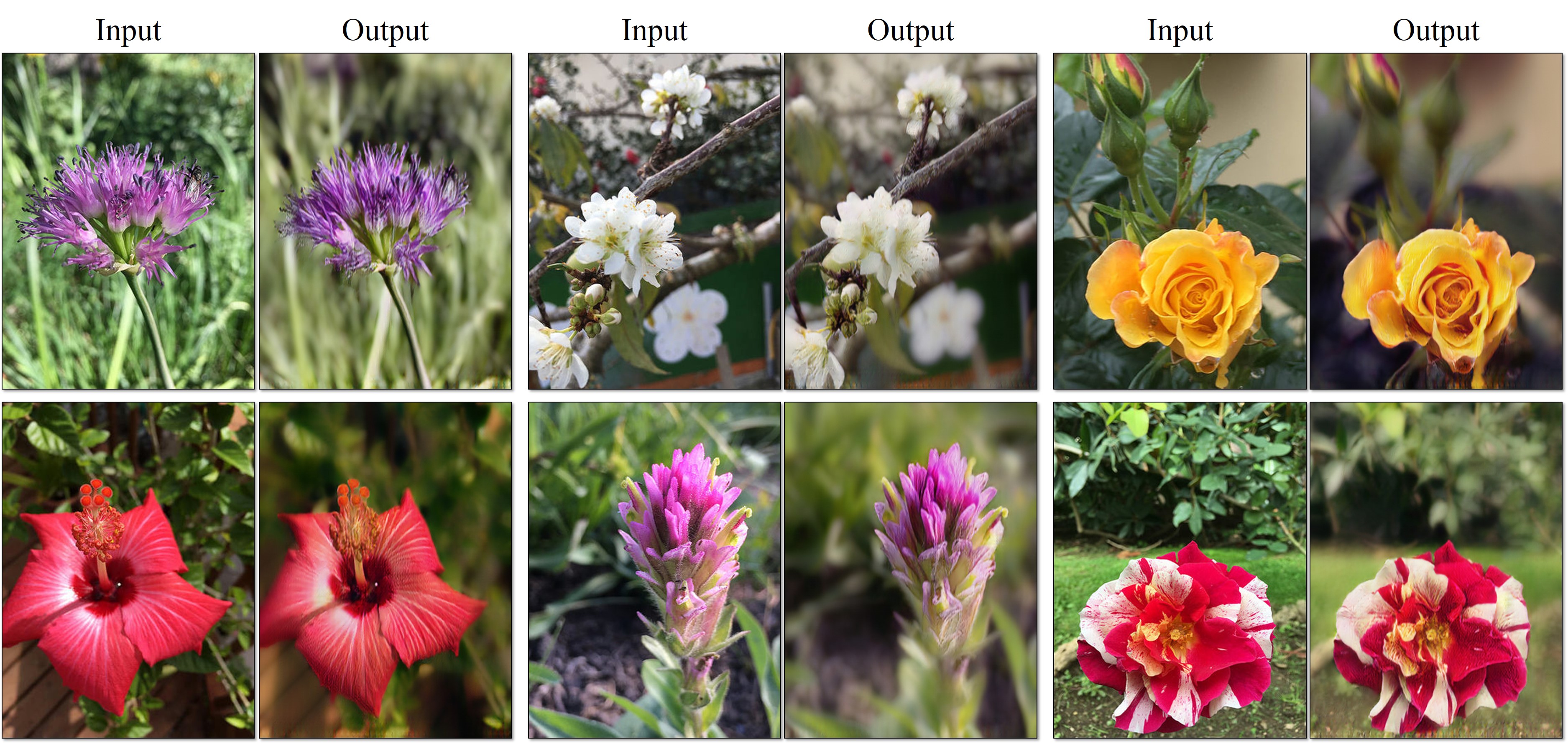 ## Prerequisites
- Linux or OSX
- NVIDIA GPU + CUDA CuDNN (CPU mode and CUDA without CuDNN may work with minimal modification, but untested)
- For MAC users, you need the Linux/GNU commands `gfind` and `gwc`, which can be installed with `brew install findutils coreutils`.
## Getting Started
### Installation
- Install torch and dependencies from https://github.com/torch/distro
- Install torch packages `nngraph`, `class`, `display`
```bash
luarocks install nngraph
luarocks install class
luarocks install https://raw.githubusercontent.com/szym/display/master/display-scm-0.rockspec
```
- Clone this repo:
```bash
git clone https://github.com/junyanz/CycleGAN
cd CycleGAN
```
### Apply a Pre-trained Model
- Download the test photos (taken by [Alexei Efros](https://www.flickr.com/photos/aaefros)):
```
bash ./datasets/download_dataset.sh ae_photos
```
- Download the pre-trained model `style_cezanne` (For CPU model, use `style_cezanne_cpu`):
```
bash ./pretrained_models/download_model.sh style_cezanne
```
- Now, let's generate Paul Czanne style images:
```
DATA_ROOT=./datasets/ae_photos name=style_cezanne_pretrained model=one_direction_test phase=test loadSize=256 fineSize=256 resize_or_crop="scale_width" th test.lua
```
The test results will be saved to `./results/style_cezanne_pretrained/latest_test/index.html`.
Please refer to [Model Zoo](#model-zoo) for more pre-trained models.
`./examples/test_vangogh_style_on_ae_photos.sh` is an example script that downloads the pretrained Van Gogh style network and runs it on Efros's photos.
### Train
- Download a dataset (e.g. zebra and horse images from ImageNet):
```bash
bash ./datasets/download_dataset.sh horse2zebra
```
- Train a model:
```bash
DATA_ROOT=./datasets/horse2zebra name=horse2zebra_model th train.lua
```
- (CPU only) The same training command without using a GPU or CUDNN. Setting the environment variables ```gpu=0 cudnn=0``` forces CPU only
```bash
DATA_ROOT=./datasets/horse2zebra name=horse2zebra_model gpu=0 cudnn=0 th train.lua
```
- (Optionally) start the display server to view results as the model trains. (See [Display UI](#display-ui) for more details):
```bash
th -ldisplay.start 8000 0.0.0.0
```
### Test
- Finally, test the model:
```bash
DATA_ROOT=./datasets/horse2zebra name=horse2zebra_model phase=test th test.lua
```
The test results will be saved to an HTML file here: `./results/horse2zebra_model/latest_test/index.html`.
## Model Zoo
Download the pre-trained models with the following script. The model will be saved to `./checkpoints/model_name/latest_net_G.t7`.
```bash
bash ./pretrained_models/download_model.sh model_name
```
- `orange2apple` (orange -> apple) and `apple2orange`: trained on ImageNet categories `apple` and `orange`.
- `horse2zebra` (horse -> zebra) and `zebra2horse` (zebra -> horse): trained on ImageNet categories `horse` and `zebra`.
- `style_monet` (landscape photo -> Monet painting style), `style_vangogh` (landscape photo -> Van Gogh painting style), `style_ukiyoe` (landscape photo -> Ukiyo-e painting style), `style_cezanne` (landscape photo -> Cezanne painting style): trained on paintings and Flickr landscape photos.
- `monet2photo` (Monet paintings -> real landscape): trained on paintings and Flickr landscape photographs.
- `cityscapes_photo2label` (street scene -> label) and `cityscapes_label2photo` (label -> street scene): trained on the Cityscapes dataset.
- `map2sat` (map -> aerial photo) and `sat2map` (aerial photo -> map): trained on Google maps.
- `iphone2dslr_flower` (iPhone photos of flowers -> DSLR photos of flowers): trained on Flickr photos.
CPU models can be downloaded using:
```bash
bash pretrained_models/download_model.sh
## Prerequisites
- Linux or OSX
- NVIDIA GPU + CUDA CuDNN (CPU mode and CUDA without CuDNN may work with minimal modification, but untested)
- For MAC users, you need the Linux/GNU commands `gfind` and `gwc`, which can be installed with `brew install findutils coreutils`.
## Getting Started
### Installation
- Install torch and dependencies from https://github.com/torch/distro
- Install torch packages `nngraph`, `class`, `display`
```bash
luarocks install nngraph
luarocks install class
luarocks install https://raw.githubusercontent.com/szym/display/master/display-scm-0.rockspec
```
- Clone this repo:
```bash
git clone https://github.com/junyanz/CycleGAN
cd CycleGAN
```
### Apply a Pre-trained Model
- Download the test photos (taken by [Alexei Efros](https://www.flickr.com/photos/aaefros)):
```
bash ./datasets/download_dataset.sh ae_photos
```
- Download the pre-trained model `style_cezanne` (For CPU model, use `style_cezanne_cpu`):
```
bash ./pretrained_models/download_model.sh style_cezanne
```
- Now, let's generate Paul Czanne style images:
```
DATA_ROOT=./datasets/ae_photos name=style_cezanne_pretrained model=one_direction_test phase=test loadSize=256 fineSize=256 resize_or_crop="scale_width" th test.lua
```
The test results will be saved to `./results/style_cezanne_pretrained/latest_test/index.html`.
Please refer to [Model Zoo](#model-zoo) for more pre-trained models.
`./examples/test_vangogh_style_on_ae_photos.sh` is an example script that downloads the pretrained Van Gogh style network and runs it on Efros's photos.
### Train
- Download a dataset (e.g. zebra and horse images from ImageNet):
```bash
bash ./datasets/download_dataset.sh horse2zebra
```
- Train a model:
```bash
DATA_ROOT=./datasets/horse2zebra name=horse2zebra_model th train.lua
```
- (CPU only) The same training command without using a GPU or CUDNN. Setting the environment variables ```gpu=0 cudnn=0``` forces CPU only
```bash
DATA_ROOT=./datasets/horse2zebra name=horse2zebra_model gpu=0 cudnn=0 th train.lua
```
- (Optionally) start the display server to view results as the model trains. (See [Display UI](#display-ui) for more details):
```bash
th -ldisplay.start 8000 0.0.0.0
```
### Test
- Finally, test the model:
```bash
DATA_ROOT=./datasets/horse2zebra name=horse2zebra_model phase=test th test.lua
```
The test results will be saved to an HTML file here: `./results/horse2zebra_model/latest_test/index.html`.
## Model Zoo
Download the pre-trained models with the following script. The model will be saved to `./checkpoints/model_name/latest_net_G.t7`.
```bash
bash ./pretrained_models/download_model.sh model_name
```
- `orange2apple` (orange -> apple) and `apple2orange`: trained on ImageNet categories `apple` and `orange`.
- `horse2zebra` (horse -> zebra) and `zebra2horse` (zebra -> horse): trained on ImageNet categories `horse` and `zebra`.
- `style_monet` (landscape photo -> Monet painting style), `style_vangogh` (landscape photo -> Van Gogh painting style), `style_ukiyoe` (landscape photo -> Ukiyo-e painting style), `style_cezanne` (landscape photo -> Cezanne painting style): trained on paintings and Flickr landscape photos.
- `monet2photo` (Monet paintings -> real landscape): trained on paintings and Flickr landscape photographs.
- `cityscapes_photo2label` (street scene -> label) and `cityscapes_label2photo` (label -> street scene): trained on the Cityscapes dataset.
- `map2sat` (map -> aerial photo) and `sat2map` (aerial photo -> map): trained on Google maps.
- `iphone2dslr_flower` (iPhone photos of flowers -> DSLR photos of flowers): trained on Flickr photos.
CPU models can be downloaded using:
```bash
bash pretrained_models/download_model.sh 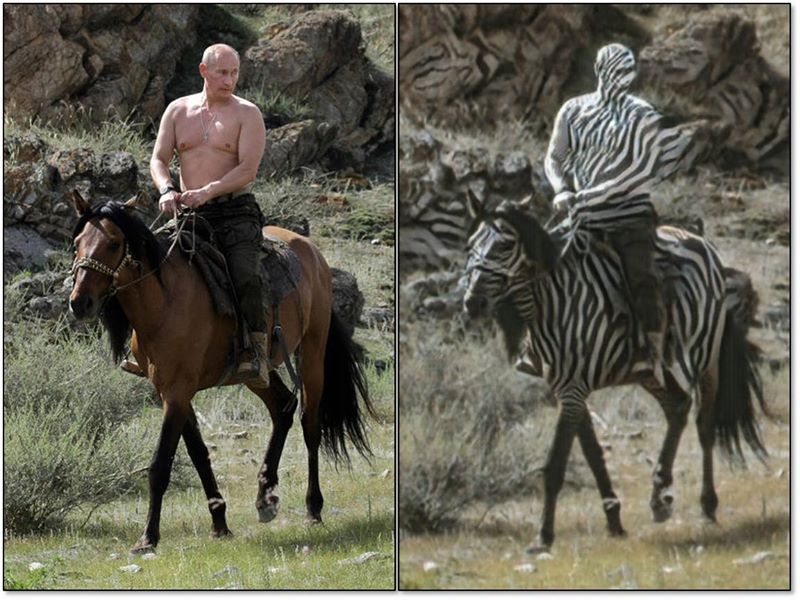 Our model does not work well when the test image is rather different from the images on which the model is trained, as is the case in the figure to the left (we trained on horses and zebras without riders, but test here one a horse with a rider). See additional typical failure cases [here](https://junyanz.github.io/CycleGAN/images/failures.jpg). On translation tasks that involve color and texture changes, like many of those reported above, the method often succeeds. We have also explored tasks that require geometric changes, with little success. For example, on the task of `dog<->cat` transfiguration, the learned translation degenerates into making minimal changes to the input. We also observe a lingering gap between the results achievable with paired training data and those achieved by our unpaired method. In some cases, this gap may be very hard -- or even impossible,-- to close: for example, our method sometimes permutes the labels for tree and building in the output of the cityscapes photos->labels task.
## Citation
If you use this code for your research, please cite our [paper](https://junyanz.github.io/CycleGAN/):
```
@inproceedings{CycleGAN2017,
title={Unpaired Image-to-Image Translation using Cycle-Consistent Adversarial Networkss},
author={Zhu, Jun-Yan and Park, Taesung and Isola, Phillip and Efros, Alexei A},
booktitle={Computer Vision (ICCV), 2017 IEEE International Conference on},
year={2017}
}
```
## Related Projects:
[pix2pix](https://github.com/phillipi/pix2pix): Image-to-image translation using conditional adversarial nets
[iGAN](https://github.com/junyanz/iGAN): Interactive Image Generation via Generative Adversarial Networks
## Cat Paper Collection
If you love cats, and love reading cool graphics, vision, and ML papers, please check out the Cat Paper [Collection](https://github.com/junyanz/CatPapers).
## Acknowledgments
Code borrows from [pix2pix](https://github.com/phillipi/pix2pix) and [DCGAN](https://github.com/soumith/dcgan.torch). The data loader is modified from [DCGAN](https://github.com/soumith/dcgan.torch) and [Context-Encoder](https://github.com/pathak22/context-encoder). The generative network is adopted from [neural-style](https://github.com/jcjohnson/neural-style) with [Instance Normalization](https://github.com/DmitryUlyanov/texture_nets/blob/master/InstanceNormalization.lua).
Our model does not work well when the test image is rather different from the images on which the model is trained, as is the case in the figure to the left (we trained on horses and zebras without riders, but test here one a horse with a rider). See additional typical failure cases [here](https://junyanz.github.io/CycleGAN/images/failures.jpg). On translation tasks that involve color and texture changes, like many of those reported above, the method often succeeds. We have also explored tasks that require geometric changes, with little success. For example, on the task of `dog<->cat` transfiguration, the learned translation degenerates into making minimal changes to the input. We also observe a lingering gap between the results achievable with paired training data and those achieved by our unpaired method. In some cases, this gap may be very hard -- or even impossible,-- to close: for example, our method sometimes permutes the labels for tree and building in the output of the cityscapes photos->labels task.
## Citation
If you use this code for your research, please cite our [paper](https://junyanz.github.io/CycleGAN/):
```
@inproceedings{CycleGAN2017,
title={Unpaired Image-to-Image Translation using Cycle-Consistent Adversarial Networkss},
author={Zhu, Jun-Yan and Park, Taesung and Isola, Phillip and Efros, Alexei A},
booktitle={Computer Vision (ICCV), 2017 IEEE International Conference on},
year={2017}
}
```
## Related Projects:
[pix2pix](https://github.com/phillipi/pix2pix): Image-to-image translation using conditional adversarial nets
[iGAN](https://github.com/junyanz/iGAN): Interactive Image Generation via Generative Adversarial Networks
## Cat Paper Collection
If you love cats, and love reading cool graphics, vision, and ML papers, please check out the Cat Paper [Collection](https://github.com/junyanz/CatPapers).
## Acknowledgments
Code borrows from [pix2pix](https://github.com/phillipi/pix2pix) and [DCGAN](https://github.com/soumith/dcgan.torch). The data loader is modified from [DCGAN](https://github.com/soumith/dcgan.torch) and [Context-Encoder](https://github.com/pathak22/context-encoder). The generative network is adopted from [neural-style](https://github.com/jcjohnson/neural-style) with [Instance Normalization](https://github.com/DmitryUlyanov/texture_nets/blob/master/InstanceNormalization.lua).
近期下载者:
相关文件:
收藏者: